England runestones
The England runestones (Swedish: Englandsstenarna) is a group of about 30 runestones in Northern Europe which refer to Viking Age voyages to England.[1] They constitute one of the largest groups of runestones that mention voyages to other countries, and they are comparable in number only to the approximately 30 Greece Runestones[2] and the 26 Ingvar Runestones, of which the latter refer to a Viking expedition to the Middle East. They were engraved in Old Norse with the Younger Futhark.

The Anglo-Saxon rulers paid large sums, Danegelds, to Vikings, who mostly came from Denmark and Sweden who arrived to the English shores during the 990s and the first decades of the 11th century. Some runestones relate of these Danegelds, such as the Yttergärde runestone, U 344, which tells of Ulf of Borresta who received the danegeld three times, and the last one he received from Canute the Great. Canute sent home most of the Vikings who had helped him conquer England, but he kept a strong bodyguard, the Þingalið, and its members are also mentioned on several runestones.[3]
The vast majority of the runestones, 27, were raised in modern-day Sweden and 17 in the oldest Swedish provinces around lake Mälaren. In contrast, modern-day Denmark has no such runestones, but there is a runestone in Scania which mentions London. There is also a runestone in Norway and a Swedish one in Schleswig, Germany.
Some Vikings, such as Guðvér did not only attack England, but also Saxony, as reported by the Grinda Runestone Sö 166 in Södermanland:[1]
Below follows a presentation of the England Runestones based on information collected from the Rundata project, organized according to location. The transcriptions from runic inscriptions into standardized Old Norse are in the Swedish and Danish dialect to facilitate comparison with the inscriptions, while the English translation provided by Rundata give the names in standard dialect (the Icelandic and Norwegian dialect).
Uppland
There are eight runestones in Uppland that mention voyages to England. Several of them were raised in memory of men who had partaken in the Danegeld in England.
U 194
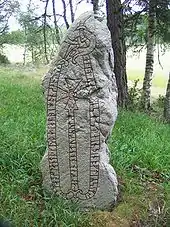
This secluded runestone is located in a grove near Väsby, Uppland, Sweden. It was raised by a Viking in commemoration of his receiving one danegeld in England. It is classified as being carved in runestone style Pr3 and, together with U 344, it has been said to be the earliest example of an Urnes style inscription in Uppland.[5] The runic text follows a common rule to only carve a single rune for two consecutive letters, even when the letters were at the end of one word and the beginning of a second word.[6] When the text shown as Latin characters, the transliterated runes are doubled and separate words are shown. For U 194 has three examples where this occurred, þinoftiʀ is transliterated as þino| |oftiʀ, tuknuts as tuk| |knuts, and anklanti as a| |anklanti.
Latin transliteration:
- al|i| |l|it raisa stain þino| |oftiʀ sik sialfan ' hon tuk| |knuts kialt a| |anklanti ' kuþ hialbi hons ant
Old Norse transcription:
- Ali/Alli let ræisa stæin þenna æftiʀ sik sialfan. Hann tok Knuts giald a Ænglandi. Guð hialpi hans and.
English translation:
- "Áli/Alli had this stone raised in memory of himself. He took Knútr's payment in England. May God help his spirit."[7]
U 241
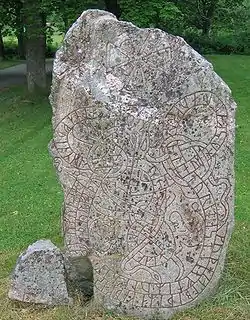
This runestone is one of the Lingsberg Runestones and was part of a paired monument with U 240. It is located on the courtyard of the estate Lingsberg in Uppland. It was raised by the grandchildren of Ulfríkr in commemoration of his receiving two danegelds in England. It is carved in runestone style Pr3.
Latin transliteration:
- n tan auk huskarl ' auk sua(i)n ' l(i)tu rita stin aftiʀ ' ulfrik ' faþurfaþur sino ' hon hafþi o| |onklanti tuh kialt| |takit + kuþ hialbi þiʀa kiþka salu| |uk| |kuþs muþ(i)
Old Norse transcription:
- En Dan ok Huskarl ok Svæinn letu retta stæin æftiʀ Ulfrik, faðurfaður sinn. Hann hafði a Ænglandi tu giald takit. Guð hialpi þæiʀa fæðga salu ok Guðs moðiʀ.
English translation:
- "And Danr and Húskarl and Sveinn had the stone erected in memory of Ulfríkr, their father's father. He had taken two payments in England. May God and God's mother help the souls of the father and son."[8]
U 344

The runestone U 344, in the style Pr3, was found in 1868, at Yttergärde, by Richard Dybeck,[9] but it is today raised at the church of Orkesta, see Orkesta Runestones. Together with U 194, it is considered to be the earliest example of the Urnes style in Uppland.[5]
The runes are written from right to left with the orientation of the runes going in the same direction, but the last words outside the runic band have the usual left-right orientation.[9] It can be dated to the first half of the 11th century because of its use of the ansuz rune for the a and æ phonemes, and because of its lack of dotted runes.[10]
This stone is notable because it commemorates that the Viking Ulf of Borresta had taken three danegelds in England.[9] The first one was with Skagul Toste in 991,[11] the second one with Thorkel the High in 1012[11] and the last one with Canute the Great in 1018.[11] Since there were many years between the danegelds, it is likely that Ulfr returned to Sweden after each danegeld to live as a wealthy magnate.[12][13]
Latin transliteration:
- in ulfr hafiʀ o| |onklati ' þru kialt| |takat þit uas fursta þis tusti ka-t ' þ(a) ---- (þ)urktil ' þa kalt knutr
Old Norse transcription:
- En Ulfʀ hafiʀ a Ænglandi þry giald takit. Þet vas fyrsta þet's Tosti ga[l]t. Þa [galt] Þorkætill. Þa galt Knutr.
English translation:
- "And Ulfr has taken three payments in England. That was the first that Tosti paid. Then Þorketill paid. Then Knútr paid."[14]
U 539

This runestone is located at the church of Husby-Sjuhundra. It is one of the older runestones as it is in the style RAK. It is raised in memory of Sveinn who intended to go to England but died en route in Jutland. Omeljan Pritsak comments that Sveinn probably died in the Limfjord, Jutland, as the fjord was usually the starting point for campaigns against England.[15] Jansson dates Svein's death to 1015, when Canute the Great's great invasion fleet had been assembled in the Limfjord, a fleet that had many young warriors from Uppland.[16] When the fleet departed for England, Sveinn was no longer aboard.[16]
The hope that God and God's mother would treat the man better than he deserved is an expression that appears on several runestones, and it is not understood as an expression of his having a bad character but it is a request that he should be favoured in the afterlife.[17]
Latin transliteration:
- A tiarfʀ × uki × urika × uk ' uiki × uk × iukiʀ × uk × kiʀialmʀ × þiʀ bryþr × aliʀ × litu × risa ×
- B stin þina × iftiʀ × suin × bruþur × sin × saʀ × uarþ × tuþr a × iut(l)ati × on skulti
- C fara × til × iklanþs × kuþ × ialbi × (o)ns × at uk salu × uk| ×| kus muþiʀ × betr × þan an karþi til
Old Norse transcription:
- A Diarfʀ ok Orøkia ok Vigi ok Iogæiʀʀ ok Gæiʀhialmʀ, þæiʀ brøðr alliʀ letu ræisa
- B stæin þenna æftiʀ Svæin, broður sinn. Saʀ varð dauðr a Iutlandi. Hann skuldi
- C fara til Ænglands. Guð hialpi hans and ok salu ok Guðs moðiʀ bætr þan hann gærði til.
English translation:
- A "Djarfr and Órœkja and Vígi and Jógeirr and Geirhjalmr, all of these brothers had"
- B "this stone raised in memory of Sveinn, their brother. He died in Jútland. He meant to"
- C "travel to England. May God and God's mother help his spirit and soul better than he deserved."[18]
U 616

This runestone is located at Tång, and it is raised in memory of a man who died in battle in England. It is classified as being carved in runestone style Pr1, but the runemaster is considered to have had little experience in the craft. The runic text contains a bind rune, which is a ligature combining two runes, for an a-rune and a l-rune, which may have been done simply to save space.[19]
Latin transliteration:
- fir--(r)iui : lit rita * kuml : yfitiʀr : fnþur : sih : baosa : auk : boruþur : kuru- * kuþ hi=a=l-... * ul kuru -ial uti * a| |akla--
Old Norse transcription:
- <fir--riui> let retta kuml æftiʀ faður sinn Bosa(?)/Bausa(?) ok broður <kuru->. Guð hial[pi] <ul> <kuru> [f]ioll uti a Ængla[ndi].
English translation:
- "<fir--riui> had the monument erected in memory of his father Bósi(?)/Bausi(?) and (his) brother <kuru->. May God help <ul> <kuru> fell abroad in England."[20]
U 812
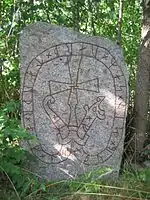
This runestone is carved in runestone style Pr2 and was raised at the church of Hjälsta. It was raised in memory of a man's father who died in England. Based on its size and runic text, it has been suggested that U 812 was once part of a coupled monument located in a cemetery, but that the runestone with the first half of the overall text has been lost.[21] Other pairs of runestones that may have formed a coupled monument in a cemetery are U 49 and U 50 in Lovö and Sö Fv1948;282 and Sö 134 in Ludgo.[21]
Latin transliteration:
- × faþur × sin × saʀ × uarþ × tauþr × o eg×loti ×
Old Norse transcription:
- faður sinn. Saʀ varð dauðr a Ænglandi.
English translation:
- "his father. He died in England."[22]
U 978
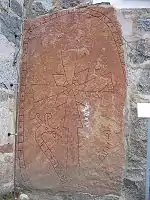
This stone is located in the wall of the church of Gamla Uppsala. It is carved in runestone style Pr2 and made of sandstone. It was made by a man who called himself "traveller to England" in memory of his father.
Latin transliteration:
- sihuiþr ...-i + stain + þina + iklats+fari + iftir + uitarf + faþ(u)(r) [+ -... ...sia]... ...ku---
Old Norse transcription:
- Sigviðr [ræist]i stæin þenna Ænglandsfari æftiʀ Vidiarf, faður ... ... ...
English translation:
- "Sigviðr, traveller to England, raised this stone in memory of Védjarfr, (his) father ... ... ..."[23]
U 1181

This fragmented runestone is classified as being carved in runestone style Fp and is located at Lilla Runhällen. It was raised by a man who had travelled to England in memory of himself.
Latin transliteration:
- ...-(i) × lit × (a)kua ... ...[k × sa](l)fan × ek-...ns*fari ' a(f)i × kunu-s *
Old Norse transcription:
- ... let haggva ... [si]k sialfan, Æng[la]ndsfari, afi <kunu-s>.
English translation:
- "... had (the stone) cut ... (in memory of) himself, traveller to England, grandfather of <kunu-s>."[24]
Södermanland
There are six known runestones in Södermanland that mention men who had travelled to England.
Sö 46

This runestone was found in Hormesta, and it is one of the older runestones as it is classified as being carved in runestone style RAK, which is considered to be the oldest style. It is raised by two men in memory of their brother who died in England.
Latin transliteration:
- iskil : auk : knauþimanr : raistu : stain : þansi : at : bruþur : sin : suera : as : uarþ : tauþr * o * eklanti kuml * kiarþu : þatsi : [kitil slakʀ]
Old Norse transcription:
- Æskell ok Gnauðimandr(?) ræistu stæin þannsi at broður sinn Sværra(?), es varð dauðr a Ænglandi. Kumbl giærðu þatsi Kætill [ok] Stakkʀ.
English translation:
- "Áskell and Gnauðimaðr(?) raised this stone in memory of their brother Sverri(?), who died in England. Ketill and Stakkr made this monument."[25]
Sö 55
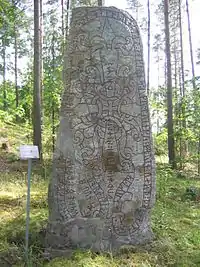
This runestone in Bjudby was raised by a man in memory of his son Hefnir who went to England and back, and instead of having a warrior's death overseas, he died at home. Due to the use of the ansuz rune for the o phoneme, Erik Brate argues that Hefnir participated in a late 11th-century expedition to England.[26] He suggests that Hefnir was part of the invasion force sent to England by Sweyn Estridsson, in 1069, and which was intended to defeat William the Conqueror's Normans.[27] The invasion had been planned for two years, but William the conqueror bought off the commander of the force who was Sweyn Estridsson's brother Asbjörn.[27] The inscription is in runestone style Pr2 and was carved by two runemasters whose names are normalized as Slode and Brune. Brune's signature is also on Sö 178 at Gripsholm Castle.
Latin transliteration:
- þorstain (l)(i)... ...sa : stain : þena : ... sik : sialfan : auk : sun : sin : hefni : uaʀ til : enklans : ukr : trenkr : farin : uarþ : þa * haima : at : harmi tauþr kuþ hialbi : sialu : þaima bruni : auk : sloþi : þaiʀ ...(u) stan þena
Old Norse transcription:
- Þorstæinn le[t ræi]sa stæin þenna [æftiʀ] sik sialfan ok sun sinn Hæfni. Vaʀ til Ænglands ungʀ drængʀ farinn, varð þa hæima at harmi dauðr. Guð hialpi sialu þæiʀa. Bruni ok Sloði þæiʀ [rist]u stæin þenna.
English translation:
- "Þorsteinn had this stone raised in memory of himself and his son Hefnir. The young valiant man travelled to England; then died grievously at home. May God help their souls. Brúni and Slóði, they carved this stone."[28]
Sö 83

This runestone has disappeared but it was located at the church of Tumbo. It is classified as possibly being in runestone style Pr4. The inscription has been attributed based on stylistic analysis to the runemaster Näsbjörn, and what little remained of the stone when it was discovered said that a man drowned in England.
Latin transliteration:
- [...an : truknaþi : i eklans : han...]
Old Norse transcription:
- [H]ann drunknaði i Ænglands ...
English translation:
- "He drowned in England's ..."[29]
Sö 160
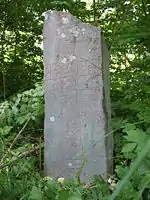
This runestone is located at the church of Råby. Like the Kolsta Runestone, it is raised in memory of a man who died in the assembly retinue (þingalið) in England.[15]
Latin transliteration:
- : aybirn : raisþi : stain : þansi : at : karþi : han uarþ : tauþr : o| |oklati i liþi
Old Norse transcription:
- Øybiorn ræisþi stæin þannsi at Skærði. Hann varð dauðr a Ænglandi i liði.
English translation:
- "Eybjǫrn raised this stone in memory of Skerðir. He died in the retinue in England."[30]
Sö 166
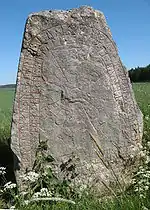
This runestone which is located in Grinda is in the style RAK. It is raised in memory of a father who divided up gold in England and attacked some towns in northern Germany. According to Omeljan Pritsak, the gold which was divided was part of the danegeld,[31] and Erik Brate argues that it was the same expedition as the one mentioned on the Berga Runestone.[32]
Latin transliteration:
- : kriutkarþr : ainriþi : suniʀ : kiarþu : at : faþur : snialan : kuþuiʀ : uaʀ uastr : a : aklati : kialti : skifti : burkiʀ : a : sahks:lanti : suti : kaula
Old Norse transcription:
- Griutgarðr, Æinriði, syniʀ, giærðu at faður sniallan. Guðveʀ vaʀ vestr a Ænglandi, gialdi skifti, borgiʀ a Saxlandi sotti karla.
English translation:
- "Grjótgarðr (and) Einriði, the sons made (the stone) in memory of (their) able father. Guðvér was in the west; divided (up) payment in England; manfully attacked townships in Saxony."[33]
Sö 207

This runestone is located at the church of Överselö. It is made of sandstone and carved in runestone style Fp. It is in memory of a father who travelled to England.
Latin transliteration:
- kuþr... ... (f)aþur sin * fur * hfila * hn * til * iklans * kuþ halbi * sil hns
Old Norse transcription:
- Guð... ... faður sinn. For hæfila hann til Ænglands. Guð hialpi sal hans.
English translation:
- "Guð-... ... his father. He competently travelled to England. May God help his soul."[34]
Västmanland
In Västmanland, there are three runestones that refer to voyages to England.
Vs 5

This runestone is located in the garden of the farm Vändle and it is tentatively categorized as being carved in runestone style Fp. It is raised in memory of a man who travelled to England.
Latin transliteration:
- [kra-hni- × lit × resa × s... ...] + uas × farin + til + ekla-s [× (t)u i × sbelbuþa × --s(a)þu × helb]i × kuþ [× se... ... ... sigi * iuk × -u...]
Old Norse transcription:
- <kra-hni-> let ræisa s[tæin] ... vas farinn til Ængla[nd]s. Do i Spiallbuða ... Hialpi Guð se[lu hans] ... Siggi hiogg [r]u[naʀ].
English translation:
- "<kra-hni-> had the stone raised ... travelled to England, died in Spjallboði's ... May God help his soul ... Siggi cut the runes."[35]
Vs 9
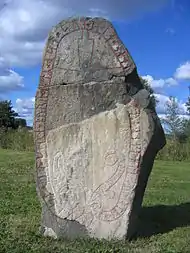
This runestone is located near the bridge of Saltängsbron and it is in the style Pr3. It is in memory of a man who died in England.
Latin transliteration:
× kisl × lit × kera × buru × eftʀ × osl × sun × sin × han u(a)[rþ] × tyþr × a eklati × kuþ ialbi × has × ont auk × selu
Old Norse transcription:
- Gisl let gærva bro æftiʀ Asl/ǫsl, sun sinn. Hann varð dauðr a Ænglandi. Guð hialpi hans and ok selu.
English translation:
- "Gísl had the bridge made in memory of Ásl/ǫsl, his son. He died in England. May God help his spirit and soul."[36]
Vs 18

This runestone is located in Berga and is classified as being carved in runestone style Fp. It was carved by the same runemaster as the Ingvar runestone Vs 19. Similar to the inscription on U 194, the runic text has an example where a single rune was used for two consecutive letters with one at the end of one word and the other at the start of a second word.[6] The runemaster on both Vs 18 and Vs 19 used the same runes trekuþan which were transliterated to show two letters and separate words as trek| |kuþan. Vs 18 and Vs 19 were also sponsored by the same person, Gunnvaldr.
Latin transliteration:
- (k)hunaltr * liet resa * sthin * þensa * iftir * kerfast * sun sen * trek| |kuþan * auk * uas farin * til eklans * hiolbi * kuþ * salu * hans
Old Norse transcription:
- Gunnaldr let ræisa stæin þennsa æftiʀ Gæiʀfast, sun sinn, dræng goðan, ok vas farinn til Ænglands. Hialpi Guð salu hans.
English translation:
- "Gunnvaldr had this stone raised in memory of Geirfastr, his son, a good valiant man. And (he) had travelled to England. May God help his soul."[37]
Gästrikland
In Gästrikland, there is only one runestone that mentions a voyage to England.
Gs 8

This is a fragment that remains of a runestone. It was found in 1927 in Västra Hästbo near the church of Torsåker, and today it is almost hidden behind a pillar inside the church. It is in sandstone and it is one of the older runestones as it is carved in runestone style RAK. This the classification for inscriptions with runic band ends which do not have any attached serpent or beast heads. The runic text indicates that it was raised in memory of a man who went to England. The last word has a bind rune that combines a k-rune and u-rune, but it has been suggested that this was done to correct an error made when carving the text.[38]
Latin transliteration:
- asmuntr -... ...faþ-... han : uas : uist : --- ikla-ti ...k=uust--
Old Norse transcription:
- Asmundr ... ... Hann vas vestr [ut a] Ængla[n]di ...
English translation:
- "Ásmundr ... ... He was abroad in the west in England ..."[39]
Östergötland
In Östergötland, there are two runestones that mention men who travelled to England, and both men died there.
Ög 104

This runestone is located in Gillberga. It is in the style Fp and it is raised in memory of a brother who died in England. The stone is located near an ancient road and was raised to its current position in 1866.
Latin transliteration:
- : ruþr : risti : stin : þinsi : iftiʀ : tuk- : bruþur : sin : saʀ : uarþ : trbin : a : ilati : triʀ : arþa : kuþr :
Old Norse transcription:
- Rauðr ræisti stæin þennsi æftiʀ Tok[a], broður sinn, saʀ varð drepinn a Ænglandi, drængʀ harða goðr.
English translation:
- "Rauðr raised this stone in memory of Tóki, his brother, a very good valiant man, who was killed in England."[40]
Ög Fv1950;341

This runestone is dated to around 1025, and it was raised in memory of a father who died in England. It was discovered in 1950 lying with the text downwards on the property of the farm Kallerstad, only 200 metres from Ög 113. It was probably found in its original location since a road used to pass the stone. The stone had been broken into two pieces, but was reassembled and raised outside of the county museum of Linköping. The stone is in greyish red granite and it is 3.95 m tall (2.98 above soil) and 1.43 m wide, and the surface is quite weathered. The name Vígfastr is otherwise unattested on runestones and also the name Helga was quite rare.[41] It is carved in runestone style Fp.[42]
The Rundata designation for this Östergötland inscription, Ög Fv1950;341, refers to the year and page number of the issue of Fornvännen in which the runestone was first described.
Latin transliteration:
- ...-iur- : auk : as-iurn : þiʀ : ristu : stin : þasi : eft-ʀ : uikfast : faþur : sin : es uas : tuþr : o : eklati : sun : helgu
Old Norse transcription:
- ...[b]ior[n] ok As[b]iorn þæiʀ ræistu stæin þasi æft[i]ʀ Vigfast, faður sinn, es vas dauðr a Ænglandi, sun Hælgu.
English translation:
- "...-bjǫrn and Ásbjǫrn, they raised this stone in memory of Vígfastr, their father, Helga's son. He died in England."[42]
Småland
In Småland, there are five or six runestones that mention voyages to England. One of them (Sm 77) mentions a man who was a marshal (stallari) in England.
Sm 5
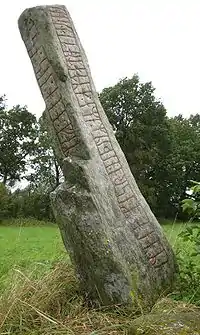
This runestone is located in Transjö. It is one of the older stones as it is in the style RAK. The runes are unusual as the m-runes are dotted (![]() ) and the k-runes have a stroke to the left instead of to the right. The stone was raised in memory of a son who died in England named Ketill, who was described as being óníðingr. Óníðingr, which with the ó- prefix means the opposite of the Old Norse pejorative word níðingr, was used to describe a man as being virtuous and is translated in the Rundata database as "unvillainous." It is used as a descriptive term on inscriptions Sö 189 in Åkerby, Sm 37 in Rörbro, Sm 147 in Vasta Ed, and DR 68 in Århus, and appears as a name or part of a name on inscriptions Ög 77 in Hovgården, Ög 217 in Oppeby, Sm 2 in Aringsås, and Sm 131 in Hjortholmen.[43] The text on Sm 5, Sm 37, and Ög 77 use the same exact phrase manna mæstr oniðingʀ or "most unvillainous of men" to describe the deceased,[43] and DR 68 uses a variant of this phrase.[44]
) and the k-runes have a stroke to the left instead of to the right. The stone was raised in memory of a son who died in England named Ketill, who was described as being óníðingr. Óníðingr, which with the ó- prefix means the opposite of the Old Norse pejorative word níðingr, was used to describe a man as being virtuous and is translated in the Rundata database as "unvillainous." It is used as a descriptive term on inscriptions Sö 189 in Åkerby, Sm 37 in Rörbro, Sm 147 in Vasta Ed, and DR 68 in Århus, and appears as a name or part of a name on inscriptions Ög 77 in Hovgården, Ög 217 in Oppeby, Sm 2 in Aringsås, and Sm 131 in Hjortholmen.[43] The text on Sm 5, Sm 37, and Ög 77 use the same exact phrase manna mæstr oniðingʀ or "most unvillainous of men" to describe the deceased,[43] and DR 68 uses a variant of this phrase.[44]
Latin transliteration:
- A : kotr : sati : sten : þana : eftʀ : ketil :
- B : sun : sin : han : faʀ :
- C : mana : mesr o:niþikʀ : eʀ a : eklati : ali : tunþi
Old Norse transcription:
- A Gautr satti stæin þenna æftiʀ Kætil,
- B sun sinn. Hann vaʀ
- C manna mæstr oniðingʀ, eʀ a Ænglandi aldri tyndi.
English translation:
- A "Gautr placed this stone in memory of Ketill"
- B "his son. He was"
- C "the most unvillainous of men, who forfeited his life in England."[45]
Sm 27
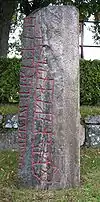
This runestone is raised on the cemetery of the church of Berga. It is classified as being in runestone style RAK and it is consequently one of the older runestones. It is raised in memory of a man who died in England.
Latin transliteration:
- --rþr * ris(t)i * kuml * þe... ... ...-aþis * o * eklanti *
Old Norse transcription:
- [Þo]rðr ræisti kumbl þe[ssi]/þe[tta] ... [ænd]aðis a Ænglandi.
English translation:
- "Þórðr raised this/these(?) monument(s) ... met his end in England."[46]
Sm 29

This runestone is located in Ingelstad. It is carved in runestone style RAK and is consequently one of the older runestones. It was raised in memory of a father who died in England.
Latin transliteration:
- ...r rsþi * stin * iftiʀ * þur--(ʀ) * fa-ur * sin * saʀ * etaþis * o * -klanti *
Old Norse transcription:
- ... ræisþi stæin æftiʀ Þor[gæi]ʀ, fa[ð]ur sinn. Saʀ ændaðis a [Æ]nglandi.
English translation:
- "... raised the stone in memory of Þorgeirr, his father. He met his end in England."[47]
Sm 77

This runestone is located in Sävsjö, and it is raised by Vrái in memory of a brother who died in England. Later, Vrái would also receive a memorial, the nearby Komstad Runestone which tells that Vrái had been the marshall (stallari) of an earl Hakon,[48] who was probably the earl Håkon Eiriksson.[16][31]
Latin transliteration:
- : urai : sati : stin : þonsi : eftiʀ : kuna : bruþur : sin : han : uaʀ tauþr : o : iklati
Old Norse transcription:
- Vrai satti stæin þannsi æftiʀ Gunna, broður sinn. Hann vaʀ dauðr a Ænglandi.
English translation:
- "Vrái placed this stone in memory of Gunni, his brother. He died in England."[49]
Sm 101

The Nävelsjö runestone is located at the estate of Nöbbelesholm, and it is raised in memory of a father who died in England and was buried by his brother in Bath, Somerset.
Latin transliteration:
- : kun(t)(k)el : sati : sten : þansi : eftiʀ : kunar : faþur : sin : sun : hruþa : halgi : lagþi : han : i : sten:þr : bruþur : sin : a : haklati : i : baþum
Old Norse transcription:
- Gunnkell satti stæin þannsi æftiʀ Gunnar, faður sinn, sun Hroða. Hælgi lagði hann i stæinþro, broður sinn, a Ænglandi i Baðum.
English translation:
- "Gunnkell placed this stone in memory of Gunnarr, his father, Hróði's son. Helgi, his brother, laid him in a stone coffin in Bath in England."[50]
Sm 104

This fragment of a runestone is located in the atrium of the church of Vetlanda and what remains appears to say "in the west in England."
Latin transliteration:
- ...(l)ika : uastr * a * i...-ti
Old Norse transcription:
- ... vestr a Æ[nglan]di(?).
English translation:
- "... in the west in England(?)."[51]
Västergötland
Vg 20
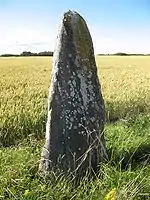
This runestone is located in Västanåker and is classified as being carved in runestone style RAK. It was raised as a memorial to a son who died in England.
Latin transliteration:
- ... risti × stin × iftiʀ × kurmar × sun × sin + iaʀ × uaʀ + trbin × a × iklanti ×
Old Norse transcription:
- ... ræisti stæin æftiʀ Guðmar(?), sun sinn. Eʀ vaʀ drepinn a Ænglandi.
English translation:
- "... raised the stone in memory of Guðmarr(?), his son, who was killed in England."[52]
Vg 187

This runestone is located at the church of Vist. It is carved in runestone style RAK and it is thus one of the older runestones. It was raised in memory of a brother who died in England.
Latin transliteration:
- + giʀi * sati * stin * þana * eftiʀ * kuþa * bruþur * sin * eʀ * a ok*lanti * altri * tynþi ×
Old Norse transcription:
- Gæiʀi satti stæin þenna æftiʀ Guða, broður sinn. Eʀ a Ænglandi aldri tynði.
English translation:
- "Geiri placed this stone in memory of Guði, his brother, who forfeited his life in England."[53]
Scania
DR 337
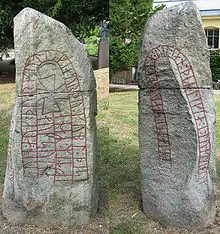
This runestone is located in Valleberga at "runestone hill" in Lund. It is one of the older runestones as it is classified as being carved in runestone style RAK.
Latin transliteration:
- A : suin : auk : þurgutr : kiaurþu : kubl : þisi ¶ eftiʀ : mana ¶ auk * suina
- B kuþ : hialbi : siaul : þeʀa : uel : ian : þeʀ : likia : i : luntunum
Old Norse transcription:
- A Swen ok Þorgotr/Þorgundr gærþu kumbl þæssi æftiʀ Manna ok Swena.
- B Guþ hialpi siol þeʀa wæl, æn þeʀ liggia i Lundunum.
English translation:
- A "Sveinn and Þorgautr/Þorgunn made this monument in memory of Manni and Sveini."
- B "May God well help their souls. And they lie in London."[54]
Germany
DR 6

This runestone is located in Schleswig Cathedral. The ornamentation shows that it was made by a Swede. It was made in memory of a man who lay dead in a location called Skía in Old Norse in England. According to Omeljan Pritsak, Skía was probably Shoebury in Essex or Skidby in Yorkshire.[55]
Latin transliteration:
- A ... l(i)t (:) r(i)(s)(a) : stain : e...
- B ...-an : s(u)(l)... ¶ ... ...(a)uþr : ... ¶ ...(n) : auk : kuþmuntr : þaʀ [:] [r]... ...[(a)ʀ]
- C : a enklanti : i skiu (:) -uilis : kr... ... ...
Old Norse transcription:
- B ... ... ... [d]øþr ... ... ok Guþmundr þeʀ r[istu run]aʀ.
- C A Ænglandi i Skiu [h]wilis. Kr[istr](?) ... ...
English translation:
- A "... had the stone raised in memory of"
- B "... ... ... dead ... ... and Guðmundr, they carved the runes."
- C "(He) rests at Skía in England. Christ ... ..."[56]
United Kingdom
E 2
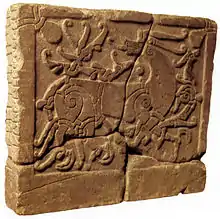
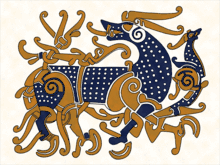
This runestone, also known as Br E2), is a Viking Age runic inscription from the early 11th century, in a coffin of limestone in Saint Paul's Cathedral in London.[57] The stone is in style Pr2, also known as Ringerike style.[57] It has remains of dark blue and red colour.[57] The stone is placed in the Museum of London.[58]
It is possible that it was made in memory of a Viking warrior who died in service of king Canute the Great,[59] and the creature on the stone may represent Sleipnir, Odin's eight-legged horse.[60]
Latin transliteration:
- : k-na : let : legia : st¶in : þensi : auk : tuki :
Old Norse transcription:
- G[i]nna(?)/G[í]na(?) lét leggja stein þenna ok Tóki.
English translation:
- "Ginna(?)/Gína(?) had this stone laid and (i.e. with) Tóki."
Norway
N 184
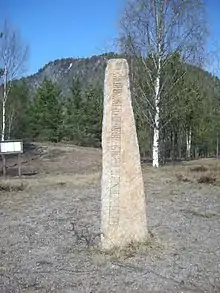
This runestone is located in Galteland in Aust-Agder. It is an older runestone as it is classified as being in runestone style RAK. It was raised in memory of a son who died in service with the army of Canute the Great when he attacked England.
Latin transliteration:
- arn×[stin] × risti × stin × þi[na] × iftir × bior × [s]un × sin × [sa × uar] tuþr × i liþi × þ[(o)s × knutr soti × iklot +] ¶ × in is ko[þ]
Old Norse transcription:
- Arnsteinn reisti stein þenna eptir Bjór, son sinn. Sá varð dauðr í liði, þá's Knútr sótti England. Einn er Guð.
English translation:
- "Arnsteinn raised this stone in memory of Bjórr his son who died in the retinue when Knútr attacked England. God is one."[61]
Notes
- Harrison & Svensson 2007:199
- Jansson 1980:34.
- Harrison & Svensson 2007:198.
- Entry Sö 166 in Rundata 2.0 for Windows.
- Horn Fuglesang 1998:201.
- Page 1987:22.
- Entry U 194 in Rundata 2.0 for Windows.http://www.nordiska.uu.se/forskn/samnord.htm
- Entry U 241 Samnordisk runtextdatabas.
- Enoksen 1998:122.
- Enoksen 1998:124.
- Pritsak 1981:392.
- Enoksen 1998:125.
- Jansson 1980:36.
- Entry U 344 in Rundata 2.0 for Windows.
- Pritsak 1981:339.
- Jansson 1980:38.
- Jansson 1987:116.
- Entry U 539 in Rundata 2.0 for Windows.
- MacLeod 2002:134.
- Entry U 616 in Rundata 2.0 for Windows.
- Bäckvall 2010:6.
- Entry U 812 in Rundata 2.0 for Windows.
- Entry U 978 in Rundata 2.0 for Windows.
- Entry U 1181 in Rundata 2.0 for Windows.
- Entry Sö 46 in Rundata 2.0 for Windows.
- Brate 1922:60.
- Brate 1922:61.
- Entry Sö 55 in Rundata 2.0 for Windows.
- Entry Sö 83 in Rundata 2.0 for Windows.
- Entry Sö 160 in Rundata 2.0 for Windows.
- Pritsak 1981:343.
- Brate 1922:62.
- Entry Sö 166 in Rundata 2.0 for Windows.
- Entry Sö 207 in Rundata 2.0 for Windows.
- Entry Vs 5 in Rundata 2.0 for Windows.
- Entry Vs 9 in Rundata 2.0 for Windows.
- Entry Vs 18 in Rundata 2.0 for Windows.
- MacLeod 2002:123, 145.
- Entry Gs 8 in Rundata 2.0 for Windows.
- Entry Ög 104 in Rundata 2.0 for Windows.
- Jansson 1950:341-342.
- Entry Ög Fv1950;341 in Rundata 2.0 for Windows.
- Zilmer 2005:178.
- Naumann 1994:499-500.
- Entry Sm 5 in Rundata 2.0 for Windows.
- Entry Sm 27 in Rundata 2.0 for Windows.
- Entry Sm 29 in Rundata 2.0 for Windows.
- Pritsak 1981:411.
- Entry Sm 77 in Rundata 2.0 for Windows.
- Entry Sm 101 in Rundata 2.0 for Windows.
- Entry Sm 104 in Rundata 2.0 for Windows.
- Entry Vg 20 in Rundata 2.0 for Windows.
- Entry Vg 187 in Rundata 2.0 for Windows.
- Entry Dr 337 in Rundata 2.0 for Windows.
- Pritsak 1981:342.
- Entry Dr 6 in Rundata 2.0 for Windows.
- Scandinavian Runic-text Database - Rundata.
- "Rectangular grave slab: 11th century". Museum of London. Retrieved 2019-11-29.
- Simon Keynes: The Burial of King Æthelred the Unready at St Paul’s. W: The English and Their Legacy, 900-1200. Essays in Honour of Ann Williams. edited by David Roffe. Woodbridge: Boydell Press, 2012, s. 141-142. ISBN 978-1-84383-794-7.
- Forte, Oram, and Pedersen (2005), Viking Empires, ISBN 0-521-82992-5 p. 73
- Entry N 184 in Rundata 2.0 for Windows.
Sources
- Bäckvall, Maja (2010), "Dvärgstenen U 359 Skepptuna k:a (pre-symposium version)" (PDF), Runes in Context, Seventh International Symposium on Runes and Runic Inscriptions, Oslo, Norway
- Brate, Erik. (1922). Sverges Runinskrifter. Stockholm, Natur & Kultur.
- Enoksen, Lars Magnar. (1998). Runor : Historia, Tydning, Tolkning. Historiska Media, Falun. ISBN 91-88930-32-7
- Harrison, D. & Svensson, K. (2007). Vikingaliv. Fälth & Hässler, Värnamo. ISBN 978-91-27-35725-9.
- Horn Fuglesang, Signe. (1998). Swedish Runestones of the Eleventh Century: Ornament and Dating, Runeninschriften als Quellen Interdisziplinärer Forschung (K.Düwel ed.). Göttingen ISBN 3-11-015455-2
- Jansson, Sven B. F. (1950). "Några Nyligen Uppdagade Runstenar" (PDF). Fornvännen. Swedish National Heritage Board. 45: 330–344. ISSN 1404-9430. Retrieved 17 August 2010.
- Jansson, Sven B. F. (1980). Runstenar. STF, Stockholm. ISBN 91-7156-015-7
- Jansson, Sven B. F. (1987), Runes in Sweden, Gidlunds, ISBN 917844067X
- MacLeod, Mindy (2002). Bind-Runes: An Investigation of Ligatures in Runic Epigraphy. Uppsala Universitet. ISBN 91-506-1534-3.
- Naumann, Hans-Peter (1994). ""Hann var manna mestr oniðingr": Zer Poetizität Metrischer Runeninschriften". In Hoops, Johannes; Beck, Heinrich (eds.). Reallexikon der Germanischen Altertumskunde (in German). Berlin: Walter de Gruyter. pp. 490–502. ISBN 3-11-012978-7.
- Page, Raymond Ian (1987). Runes. University of California Press. ISBN 0-520-06114-4.
- Peterson, Lena. Nordisk Runnamslexikon at the Swedish Institute for Linguistics and Heritage (Institutet för språk och folkminnen).
- Pritsak, Omeljan. (1981). The Origin of Rus'. Cambridge, Mass.: Distributed by Harvard University Press for the Harvard Ukrainian Research Institute. ISBN 0-674-64465-4
- Zilmer, Kristel (2005). "He Drowned in Holmr's Sea": Baltic Traffic in Early Nordic Sources (PDF). Tartu University Press. ISBN 9949-11-090-4. Archived from the original (PDF) on 2011-07-20.
- Project Samnordisk Runtextdatabas Svensk - Rundata
External links
- An English Dictionary of Runic Inscriptions of the Younger Futhark, at the University of Nottingham
- Seventh International Symposium on Runes and Runic Inscriptions